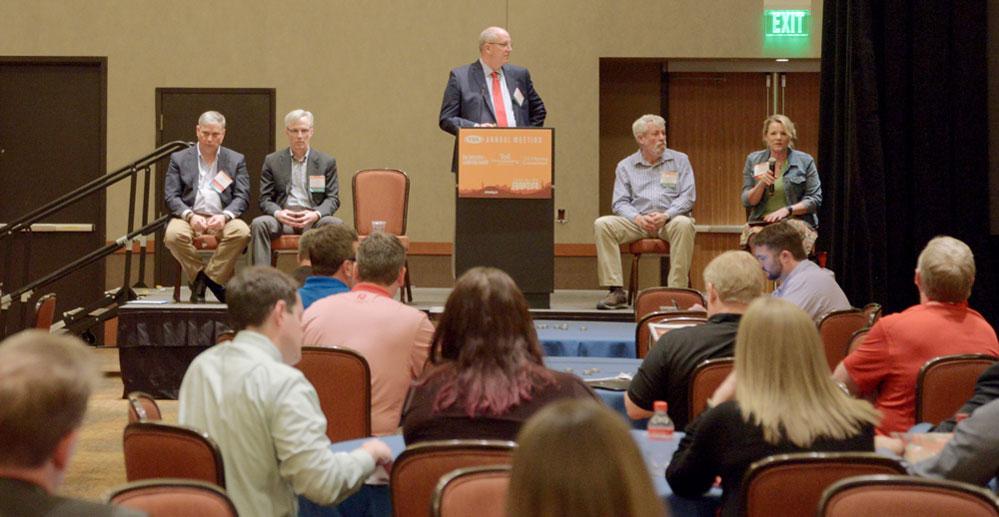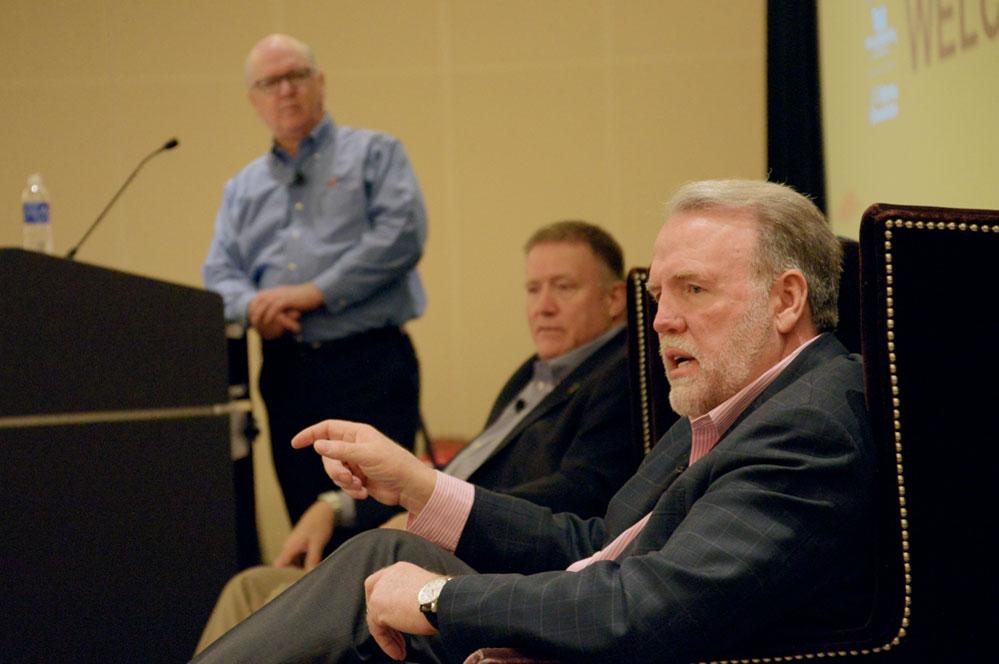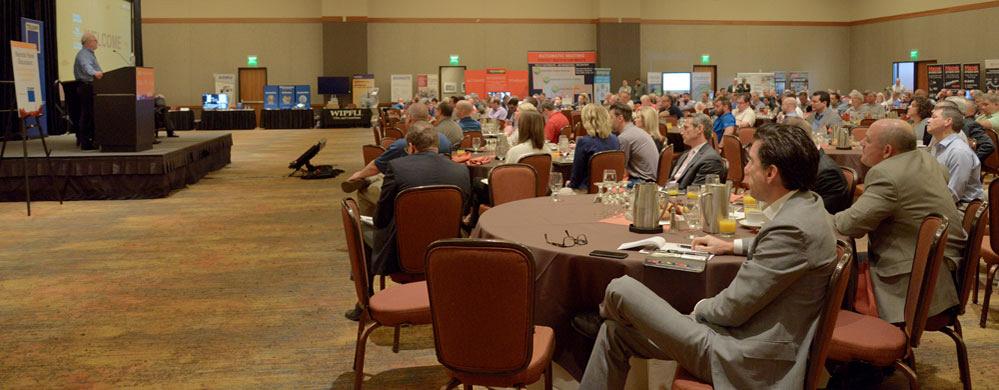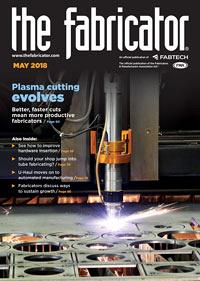Senior Editor
- FMA
- The Fabricator
- FABTECH
- Canadian Metalworking
Categories
- Additive Manufacturing
- Aluminum Welding
- Arc Welding
- Assembly and Joining
- Automation and Robotics
- Bending and Forming
- Consumables
- Cutting and Weld Prep
- Electric Vehicles
- En Español
- Finishing
- Hydroforming
- Laser Cutting
- Laser Welding
- Machining
- Manufacturing Software
- Materials Handling
- Metals/Materials
- Oxyfuel Cutting
- Plasma Cutting
- Power Tools
- Punching and Other Holemaking
- Roll Forming
- Safety
- Sawing
- Shearing
- Shop Management
- Testing and Measuring
- Tube and Pipe Fabrication
- Tube and Pipe Production
- Waterjet Cutting
Industry Directory
Webcasts
Podcasts
FAB 40
Advertise
Subscribe
Account Login
Search
The FABRICATOR’s Leadership Summit report: Metal fabricators plan for growth
FMA Annual Meeting participants navigate the headwinds and tailwinds of 2018
- By Tim Heston
- May 6, 2018
- Article
- Shop Management

The FABRICATOR’s Group Publisher Dave Brambert moderates a panel of four custom fabricator executives: Edwin Stanley of GH Metal Solutions, John Axelberg of General Stamping & Metalworks, Don Kammerzell of K-zell Metals, and Lori Tapani of Wyoming Machine Inc.
The current year is turning out to be a dynamic one for metal fabricators. Some are busting at the seams, trying to hire, train, and bring in equipment to meet rising demands for capacity. When customers grow, so do the custom fabricators serving them.
Throughout 2017 fabricators benefited from a business-friendly presidential administration. Regulations were cut, the corporate tax rate fell, the R&D tax credit was made permanent, and portions of the tax code were rewritten to encourage investment. Then came the new year and a host of challenges, from rising material prices and steel and aluminum tariffs to politicians’ saber rattling about trade wars.
All this was the backdrop for The FABRICATOR’s Leadership Summit, part of the Fabricators & Manufacturers Association’s Annual Meeting. The event drew more than 300 industry leaders to Scottsdale, Ariz., March 7-9, not long after the Trump administration announced its steel and aluminum tariffs.
The keynote panel included Ladd Hall, executive vice president of Nucor Corp., Don McNeeley, president and CEO of Chicago Tube & Iron Co., and John Packard, founder and publisher of “Steel Market Update.”
The discussion was extraordinarily timely. Packard even kept his phone’s news feed on the podium, lest news about tariffs and trade should change during his talk. And news has of course changed since the panel discussion took place at the FMA meeting.
But whether one was for or against tariffs, all could agree with one comment McNeeley made during his keynote: “Everybody is interested in our industry now, and issue No. 1 is education. The real shortage is in leadership. Where’s the next generation of leaders going to come from?”
Those leaders will need to know how to deal with the challenges fabricators face, from trade and tariffs and finding good employees to investing in the right machines and technology. Amid a whirlwind of news, the FMA event ultimately was about how, in the face of tailwinds and headwinds, a metal fabricator can grow.
Producing More
Representatives from five major machine tool providers—Amada America Inc., BLM Group, Bystronic, MC Machinery Systems, and TRUMPF—talked about how technology can help each person produce more, faster. Their focus was not on how many inches per minute this or that laser cuts, but on how quickly quality products can flow through a plant. To produce more, part velocity is key, and machines connected with software can be one tool to make it happen.
aving the right tools and technology is a critical piece of the puzzle—no shop can compete without it—but it’s not the whole puzzle, as executives on a separate best practices panel discussed at length.
“We firmly believe in the old saying, you’re either growing or shrinking. You can’t stand still for very long.”

Don McNeeley, president and CEO of Chicago Tube & Iron, speaks about the industry’s challenges during the keynote panel discussion, with fellow panelists Ladd Hall, executive vice president of flat rolled products for Nucor Corp., and (standing) John Packard, founder and publisher of “Steel Market Update.”
That was panelist Edwin Stanley, vice president of operations at GH Metal Solutions, Fort Payne, Ala. The panel consisted of executives from two large fabricators with several hundred employees—GH Metal Solutions and South Bend, Ind.-based General Stamping & Metalworks—along with two smaller fabricators with fewer than 50 employees—K-zell Metals in Phoenix and Wyoming Machine in Stacy, Minn. All four essentially discussed ways their companies would grow in the modern manufacturing world, where each resource must provide more value than ever.
People, Culture, and Company Size
This situation has led to the labor challenge that most fabricators—and most companies in general—now face. Each person needs to produce more and adapt quickly to changing demands.
Stanley described what his company calls “the A team,” a team of relief operators who can move where needed. “They know how to weld, run a press brake, run a laser, deburr. But we tell them, when you sign up for it, it’s about providing service with a smile. If you need to grind this week, you’re going to smile while you grind. But you’ll also be paid the same as if you were welding.”
The industry needs more shop floor A teams, but it also needs more engineers who can work not only in sheet metal, but also with automation. Ultimately, fabricators need to match the talent with the right processes and technology.
The best approach is rarely obvious, a point exemplified by John Axelberg, president and a third-generation owner of General Stamping & Metalworks. Two years ago Axelberg gave a Leadership Summit presentation in which he detailed a novel approach to feeding sheet into lasers and punches. The leadership team analyzed principal causes of downtime in laser cutting, and they found that most of that downtime came from errors in the automation.
Considering this, they designed a system of manually driven over-under tables at each laser. The tables created a buffer location to allow the material handler to replenish machines in advance using cartridges from a high-density storage system. With the right coordination, they thought they could deliver material at just the right speed to satisfy the demands of downstream operations.
What they found is that the arrangement works, but with a big caveat. “In the manual system, execution is critical,” Axelberg said. “It’s a cultural shift, and we’re still working on it. People want to be superstars, but they can’t do it all themselves. They need to work as a team. We’ll get there. We’re learning from this, and in the end, it will make us a better organization.”
In fabrication, “better” means more responsive, which can become a challenge as companies grow. “As we’ve gotten bigger, we have more processes and procedures, and you need those,” Stanley said. “But at the same time, it’s difficult to move quickly. So we set up two satellite offices. To be honest, they can sometimes outmaneuver us.” He added those satellite plants initially were set up to serve local customers better. But with good leadership, those plants have turned into a proving ground for quick response—best practices that can then be shared throughout the organization.
Companies need to grow revenue and have sufficient procedures and levels of management to control processes, and yet no more than necessary, lest they become less responsive. This makes finding and developing talent even more imperative, considering how productive and flexible each person needs to be.
Fabricators on the panel talked of how they have extended their training and onboarding process, particularly as the boomer generation continues to retire. As Lori Tapani, co-president of Wyoming Machine, explained, “Our No. 1 issue is onboarding new employees. Historically, we’ve had low turnover. It just so happens that within the past 12 months we’ve had several retirements in key areas. We went from having less than 10 percent turnover to a 25 percent turnover.”

Hundreds listen in on an industry keynote on metals pricing and tariffs, moderated by John Packard of “Steel Market Update.” Events were unfolding mere hours before the keynote took place, and Packard kept his phone’s news feed app open on the podium, just in case news changed in the middle of his talk.
Fabricators are hunting for talent while implementing new processes for improvement. Wyoming Machine, for instance, is implementing new scheduling software. “It really helps us identify where our bottlenecks are. It works at a granular level, so we can really see our capacity level at individual work centers. And it will help us identify where we need to cross-train people so they can move throughout the day. We really need to have a flexible work force,” Tapani said.
“Employee attraction and training are at the top of our list,” Axelberg said. “The faster we can convert inexperienced new employees into productive machine operators, the faster we can bring capacity online, so we can respond to the needs of our customers. This is really core for us this year, especially as we leverage our automation. To be honest, when we began investing in automation, we really didn’t appreciate the technical expertise the automation requires. We need to carry a surplus of this expertise in order to get things to happen quickly.”
Don Kammerzell, president of K-zell Metals, chimed in with his own company’s initiative regarding staff development. “We are really focusing on how we train people, not just our workers, but also our supervisors. We’re working with an industry group to help us train people to become supervisors.”
Diversification
Diversifying the customer base becomes even more critical when current core customers continue to order more. A fabricator that grows on the back of just a few key accounts can grow extremely quickly—but fall hard.
Tapani said that Wyoming Machine has diversified its revenue significantly over the years. She added, however, that the quest toward diversified growth never stops. To that end, she and her team have tried a little “economic gardening,” a method of economic development that’s gaining some traction among some local governments. Instead of spending millions on tax breaks and other perks to lure a large corporation, economic gardening provides funding designed to help existing local businesses grow. At Wyoming Machine, Tapani worked with the county government to tap resources that could help the company better market itself.
“We now have access to four extremely high-end consultants,” Tapani said, adding that they helped the company in four key areas. They scrutinized the company’s online and social presence. They performed a geographic study focused on specific industries (via NAICS codes) and what the projected growth rates are in each. “They also provided information about how to target specific people in specific industries. What conferences should we attend? What do they read?”
She added that being proactive with marketing helps a company adapt to market forces. One force is that as customers grow, they demand more from their suppliers, which can drive up revenue quickly but also make a fabricator’s revenue more concentrated.
Demand can change when customers consolidate too. “You can do a great job working with your customer, have stellar on-time delivery and great quality,” Tapani said. “Then the company is purchased. It’s disappointing when the company that purchased your original customer decides not to work with you. We’ve had positive results so far. We visit the new company and provide as much information as we can about our capabilities and past performance. But it’s an external force that requires strategies for dealing with.”
The Fabrication Puzzle
Custom fabricators need technology and people who are engaged, curious, and well-trained to manage that technology. They need to grow capacity and add resources to compete, but also make sure that they’re getting more out of those resources than ever. They need to market themselves both to potential customers as well as potential new hires. They need to expand into new geographic areas, perhaps an entirely new business sector. It’s a business that spans sectors and sometimes faces severe pricing pressures, both at home and from abroad. Put simply, metal fabrication is complicated. Or is it?
On the first morning of the Leadership Summit, Kammerzell hosted a shop tour, and during it, Darcy Funk, K-zell’s accounting manager, cleared up the complexity with three words: “We sell time.”
Focusing on time forces everyone to focus on a critical question: Did we make money?
“We use technology in the shop to make better parts,” said Funk. “But we also use technology in the office to make better business decisions. We don’t sell products. We don’t sell stainless countertops, bent angle iron, or anything else.” Of course, the company makes all that and more, but that’s not what it’s selling. “The only thing we’re selling is time. So everything we do—our forecasting, our budgeting—it’s all based on hours.”It starts with the estimate. If it takes more hours than expected to ship a job, the job is late, and that also means profits are lower (or nonexistent). And profits are what really matters. Improvement centers on the discrepancy between the estimated and actual time.
The shop’s software helps the organization drill down to find the root causes. It could be a clocking error (someone didn’t clock in and out of a job when they should have) or perhaps unanticipated rework. But it also could be myriad other things, many of which can be solved by better training and documentation. When the shop solves these issues, profits rise and on-time-delivery performance improves.
The devil’s in the details, as described in the best practices panel and other Leadership Summit sessions. But in many respects, all those details help fabricators achieve just one thing: making better use of the time they have.
The next FMA Annual Meeting will take place March 5-7, 2019, in Nashville, Tenn.
About the Author

Tim Heston
2135 Point Blvd
Elgin, IL 60123
815-381-1314
Tim Heston, The Fabricator's senior editor, has covered the metal fabrication industry since 1998, starting his career at the American Welding Society's Welding Journal. Since then he has covered the full range of metal fabrication processes, from stamping, bending, and cutting to grinding and polishing. He joined The Fabricator's staff in October 2007.
Related Companies
subscribe now

The Fabricator is North America's leading magazine for the metal forming and fabricating industry. The magazine delivers the news, technical articles, and case histories that enable fabricators to do their jobs more efficiently. The Fabricator has served the industry since 1970.
start your free subscription- Stay connected from anywhere

Easily access valuable industry resources now with full access to the digital edition of The Fabricator.

Easily access valuable industry resources now with full access to the digital edition of The Welder.

Easily access valuable industry resources now with full access to the digital edition of The Tube and Pipe Journal.
- Podcasting
- Podcast:
- The Fabricator Podcast
- Published:
- 04/16/2024
- Running Time:
- 63:29
In this episode of The Fabricator Podcast, Caleb Chamberlain, co-founder and CEO of OSH Cut, discusses his company’s...
- Trending Articles
Tips for creating sheet metal tubes with perforations

Supporting the metal fabricating industry through FMA

JM Steel triples capacity for solar energy projects at Pennsylvania facility

Are two heads better than one in fiber laser cutting?

Fabricating favorite childhood memories

- Industry Events
16th Annual Safety Conference
- April 30 - May 1, 2024
- Elgin,
Pipe and Tube Conference
- May 21 - 22, 2024
- Omaha, NE
World-Class Roll Forming Workshop
- June 5 - 6, 2024
- Louisville, KY
Advanced Laser Application Workshop
- June 25 - 27, 2024
- Novi, MI


























